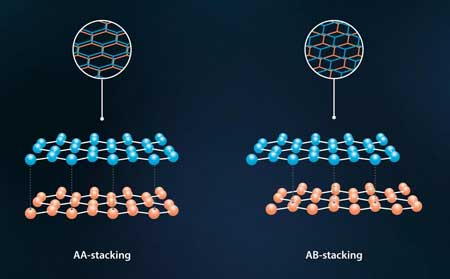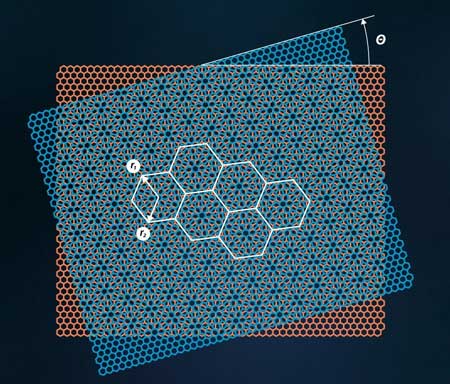| Posted: Jan 12, 2017 |
Scientists sort through bilayer graphene
(Nanowerk News) The development of microelectronics is closely associated with a search for new technology and materials for use in transistors. A promising material, graphene gripped the attention of scientists and engineers alike thanks to its unusual mechanical, electrical, and optical properties.
|
|
The graphene rush started in 2004 with the publication of a paper by Konstantin Novoselov and Andre Geim in Science ("Electric Field Effect in Atomically Thin Carbon Films"). As of today, over ten thousand papers dealing with graphene have been published and more than a thousand patents relating to the material have been granted.
|
|
Bilayer graphene, or bigraphene, is one of the exciting forms of graphene, which is currently gaining traction: In 2014 and 2015 alone, more than a thousand papers about bigraphene were published. Making sense of such an overwhelming number of experimental facts, theories, and hypotheses is far from easy, and therefore review papers dealing with the subject are highly valuable.
|
|
Reviews as such play a special role in the scientific community: Whereas original papers report the findings of individual authors or research teams, review papers reflect the overall situation in the field by identifying the current trends and challenges and helping the reader to cope with a myriad of names. For scientists all over the world, reviews offer a way to save huge amounts of time, facilitating the exchange of knowledge and speeding up scientific progress.
|
|
Dr. Alexander Rozhkov, a coauthor of the review, a leading research scientist at Laboratory No. 1 of the Institute for Theoretical and Applied Electrodynamics, and a researcher at MIPT’s Department of Electrodynamics of Complex Systems and Nanophotonics sums up the team’s achievement (Physics Report, "Electronic properties of graphene-based bilayer systems"): “To write the review on bilayer graphene, we spent two years studying and organizing all of the most significant experimental and theoretical findings in the field. As a result, we published a review citing roughly 450 scientific papers on bilayer graphene and related subjects. Right now, it is the most comprehensive review dealing with the issue, both in terms of the sheer number of references and the scope of subject matter.”
|
 |
| Fig. 1. Two types of bigraphene: AA-stacked bilayer graphene where each atom in the upper sheet sits exactly on top of an atom in the lower sheet and AB-stacked bilayer graphene where only half of the atoms in the upper sheet lie over another atom, whereas the other half lie over the center of a hexagon formed by the atoms in the lower sheet.
|
Why two is better than one
|
|
One of the attractive features of graphene is its high charge carrier mobility. In fact, it is dozens of times higher than the analogous quantity in silicon, the go-to material of modern-day microelectronics. Electrons and holes (electron vacancies) in graphene can move easily and quickly under the influence of an external electric field. However, a transistor based on single-layer graphene has a significant drawback in that it cannot be effectively switched off. This is explained by the fact that graphene does not have a bandgap, i.e., a range of energy values forbidden to its electrons. Consequently, the flow of current through such a transistor cannot be shut down completely.
|
|
The main advantage of bilayer graphene is the possibility to locally induce a bandgap and tune its magnitude by applying a strong electric field perpendicular to the carbon sheets. This means that it could be used to design next-generation transistors that would work faster and use less energy, which is especially important for portable battery-powered devices. In addition, the possibility of bandgap tuning means there is even more potential for applications in optoelectronics and sensors.
|
|
Nevertheless, a genuine microelectronics revolution is yet to come. Compared to ordinary graphene, a high-grade bilayer sample is more difficult to manufacture, since one has to control material quality and the precision of layer alignment to preserve high charge mobility and other characteristics.
|
|
There are three main types of bigraphene. In AA-stacked bilayer graphene, the layers are aligned in such a manner that each atom in the upper sheet sits exactly on top of an atom in the lower sheet. In AB-stacked bilayer graphene, the layers are overlaid in a different way, viz., only half of the atoms in the upper sheet lie over an atom, while the other half lie over the center of a hexagon in the crystal lattice of the lower sheet (see Fig. 1). In another variation, called twisted bigraphene, one layer is rotated by a predetermined angle relative the other layer. Each one of the three types has its own peculiar features, which need to be studied.
|
Graphene future
|
|
By now, many of the initially proposed theoretical schemes and concepts have been absorbed by the scientific community. Predictions made back in the pre-graphene era (the 1980s and ’90s) and shortly after the beginning of the graphene rush have been tested thanks to the rapid advances made by experimental graphene science in the last decade. At the present moment, scientists are committed to finding applications for the material. Still, fundamental researchers (not seeking any immediate applications) are also busy solving new problems arising in the field of graphene systems. For one thing, the extent to which the Coulomb repulsion between electrons can affect the properties of graphene systems remains unknown. To tackle this question, concepts relatively new to solid-state physics are discussed, e.g., the marginal Fermi liquid and topologically ordered states.
|
|
The authors of the review paper have been studying bilayer graphene for six years. They contributed to the understanding of this material’s electronic structure. In particular, they examined the possibility of spontaneous symmetry breaking in AA-stacked bilayer graphene. The researchers also theoretically predicted the instability of the electron subsystem in AA-stacked bigraphene and identified the possibility of antiferromagnetic ordering and spatially inhomogeneous states in a bilayer system.
|
|
Apart from that, the authors investigated single-electron states in twisted bilayer graphene at various twist angles and for various superlattice cell sizes, where the notion of a superlattice cell (aka moiré pattern cell; see Fig. 2) refers to a relatively large periodically occurring structure in the atomic pattern, which arises when two overlaid graphene sheets are twisted relative to each other.
|
|
Dr. Artem Sboychakov, a coauthor of the review and a senior research scientist at the Laboratory No. 1 of the Institute for Theoretical and Applied Electrodynamics commented on the publication of the review: “It is a common feature of all systems with a moiré pattern including twisted bilayer graphene that they are endowed with rather complex physics—mostly due to the intricacy of their structure. Certain aspects of their behavior such as the effects of the interactions between electrons are not yet fully understood. We should be expecting a number of exciting discoveries in this field.”
|
 |
| Fig. 2. The third type of bigraphene known as twisted bilayer graphene. The white hexagons mark the boundaries of superlattice cells (moiré pattern cells).
|
|
MIPT’s Dr. Alexander Rakhmanov who heads Laboratory No. 1 at the Institute for Theoretical and Applied Electrodynamics added: “Our team has considerable experience in the theoretical studies of electron-electron interactions in graphene-based systems. These days, besides purely analytical approaches, the role of numerical techniques cannot be overestimated. They help us find the answers to many of the important theoretical questions.
|
|
The authors of this review are primarily doing research at the RIKEN Institute of Physical and Chemical Research in Japan and at the Institute for Theoretical and Applied Electrodynamics, which collaborates closely with MIPT’s Department of Electrodynamics of Complex Systems and Nanophotonics. Between these two key institutes, we have enough computing power to conduct extensive computational studies. I think I could sum up the results of my own research and the experience we gained while writing the review by saying that we could expect graphene and systems based on this material to remain a source of scientific inspiration for many researchers—both theorists and experimentalists—for years to come.”
|


